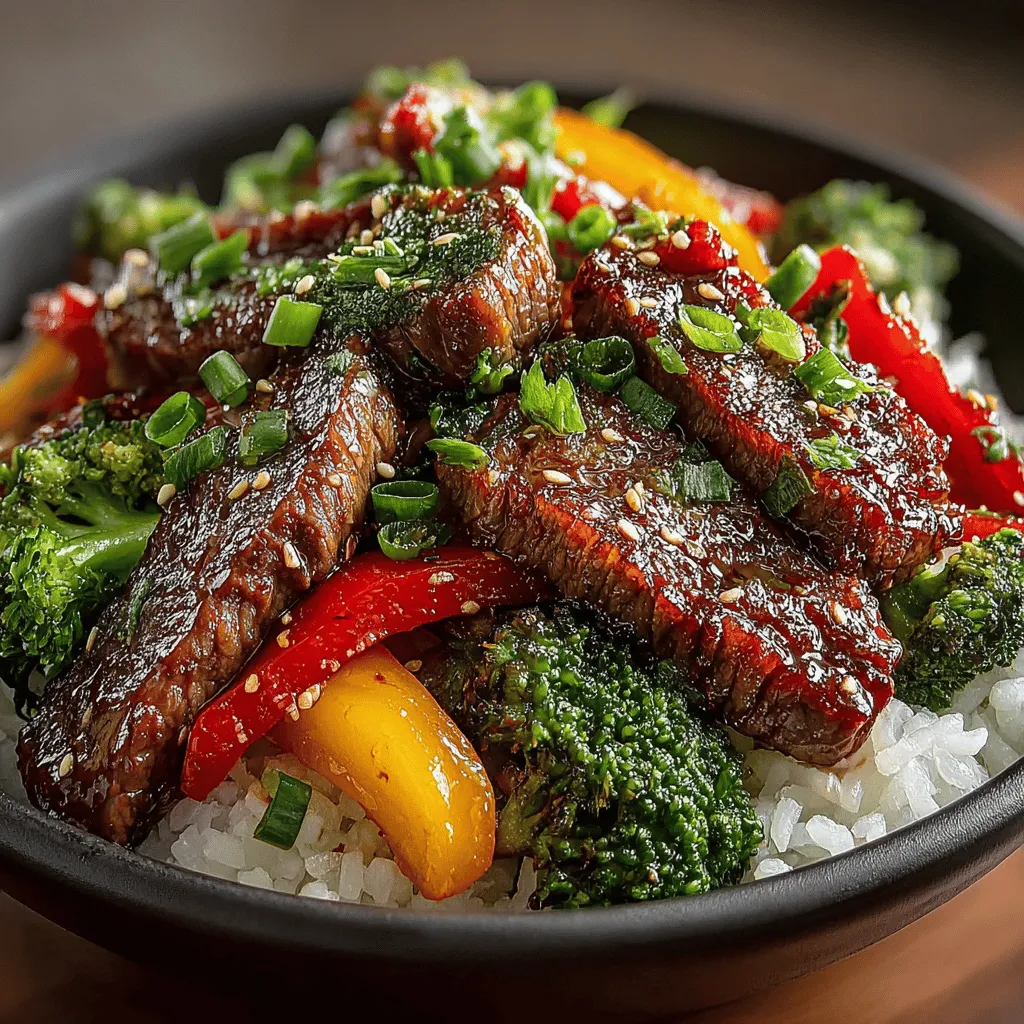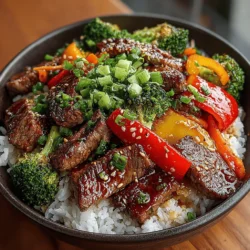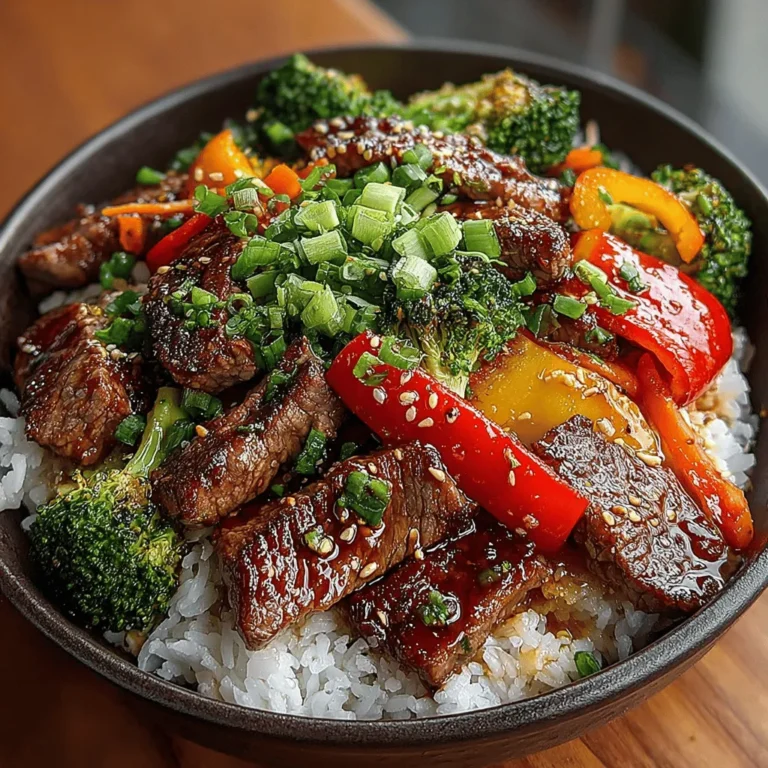Stir-frying is not just a cooking method; it’s an art form that brings together the simplicity of fresh ingredients and the elegance of quick preparation. Among the plethora of stir-fry recipes out there, Sizzling Savory Beef & Vegetable Stir-Fry stands out as a favorite for many. This dish combines tender beef, vibrant vegetables, and a savory sauce, creating a harmonious balance of flavors and textures that is both appealing and satisfying. It’s a dish that can be enjoyed by families on busy weeknights or served at gatherings to impress guests with its colorful presentation and delicious taste.
One of the greatest appeals of stir-fry meals is their ability to deliver a nutritious and hearty dish in a remarkably short amount of time. In today’s fast-paced world, finding meals that are both quick to prepare and packed with nutrients is essential for maintaining a healthy lifestyle. Stir-frying allows you to cook a variety of ingredients swiftly while preserving their vitamins and minerals, making it an ideal method for those looking to eat well without spending hours in the kitchen.
In this recipe, the sizzling beef is complemented by a medley of fresh vegetables, including bell peppers, broccoli, and carrots, all coated in a savory sauce that elevates the dish to new heights. The combination of these elements not only tantalizes the taste buds but also offers a feast for the eyes, showcasing a colorful array of ingredients that are as nutritious as they are delicious.
As you delve into the world of stir-frying, you’ll discover that this cooking technique is incredibly versatile. Whether you prefer chicken, shrimp, or tofu, the method remains largely the same, allowing you to tailor the recipe to fit your dietary preferences. The Sizzling Savory Beef & Vegetable Stir-Fry serves as an excellent introduction to stir-frying, encouraging you to experiment with different proteins and vegetables to create your ideal dish.
Understanding the Ingredients
The success of your Sizzling Savory Beef & Vegetable Stir-Fry hinges on the quality and preparation of its ingredients. Each component plays a crucial role in contributing to the overall flavor, texture, and nutritional value of the dish. Let’s take a closer look at the main ingredients that make this stir-fry so special.
Beef Sirloin
Choosing the right cut of beef is paramount for achieving tender, flavorful results. Beef sirloin is an excellent choice for stir-frying due to its balance of tenderness and flavor. This cut is relatively lean while still providing enough marbling to keep the meat juicy during cooking. When sliced thinly against the grain, beef sirloin becomes incredibly tender, making it easy to chew and enjoyable to eat.
Soy Sauce and Oyster Sauce
These two sauces are the backbone of the savory flavor profile in this dish. Soy sauce is a staple in many Asian cuisines, imparting a rich umami flavor that enhances the overall taste of the stir-fry. It provides saltiness and depth, making it a perfect base for the sauce. On the other hand, oyster sauce adds a sweet and slightly briny note, enriching the dish with a complex flavor that complements the beef and vegetables. Together, they create a mouthwatering glaze that clings to each ingredient beautifully.
Cornstarch
While it may seem like a simple ingredient, cornstarch plays a significant role in achieving the desired texture of the beef and the sauce. When marinated with cornstarch, the beef becomes tender and absorbs flavors more effectively. Additionally, when combined with the liquids in the stir-fry, cornstarch helps thicken the sauce, giving it that luscious, glossy finish that makes the dish visually appealing and flavorful.
Fresh Vegetables
The vibrant vegetables in this stir-fry not only add color but also essential nutrients. Bell peppers, broccoli, and carrots are selected for their complementary flavors, textures, and health benefits. Bell peppers offer a sweet crunch and are rich in vitamins A and C. Broccoli brings a slight bitterness and is packed with fiber and antioxidants, while carrots lend a natural sweetness and a good dose of beta-carotene. Using fresh, high-quality vegetables ensures that your stir-fry is not only delicious but also nutritious.
Garlic and Ginger
Garlic and ginger are the aromatic duo that elevates this dish to aromatic heights. Both ingredients are known for their health benefits, including anti-inflammatory properties and the ability to boost the immune system. Their distinct flavors add depth to the stir-fry, with garlic providing a pungent kick and ginger imparting a warm, peppery note. Together, they create a fragrant base that enhances the overall flavor of the dish.
Importance of Ingredient Quality
As with any recipe, the quality of your ingredients will directly impact the final result. Fresh, high-quality produce and well-sourced meats can make a world of difference in taste and texture. When preparing your Sizzling Savory Beef & Vegetable Stir-Fry, take the time to choose the best ingredients you can find. Not only will this enhance the flavor of your dish, but it will also contribute to a healthier meal overall.
Preparation Steps for Success
Before diving into the cooking process, a little preparation goes a long way in ensuring your stir-fry turns out perfectly. The following steps will help you set the stage for success.
Marinating Beef
One of the most crucial steps in preparing your beef is marinating it before cooking. A simple marinade of soy sauce, oyster sauce, and cornstarch will not only enhance the flavor but also tenderize the meat. Allow the beef to marinate for at least 30 minutes, or if time permits, a few hours in the refrigerator. This step is vital in ensuring that every bite is flavorful and tender.
Slicing Beef Against the Grain
To achieve maximum tenderness, it’s essential to slice the beef against the grain. This means cutting perpendicular to the lines of muscle fibers in the meat. By doing so, you shorten the fibers, making the meat easier to chew. Aim for thin, even slices to ensure that the beef cooks quickly and uniformly in the stir-fry.
Prepping Vegetables
Efficient preparation of vegetables is key to a successful stir-fry. Start by washing and drying your vegetables thoroughly. For bell peppers, remove the seeds and slice them into thin strips. Broccoli should be cut into bite-sized florets, while carrots can be julienned or sliced thinly. The goal is to have all your vegetables prepped and ready to go, as stir-frying is a quick process where ingredients are cooked at high heat.
Importance of Mise en Place
Mise en place, a French culinary term meaning “everything in its place,” is critical when it comes to stir-frying. Before you begin cooking, have all your ingredients measured, chopped, and ready to go. This not only streamlines the cooking process but also reduces the risk of burning or overcooking your ingredients. A well-organized workspace will allow you to focus on the cooking and ensure a seamless culinary experience.
The Cooking Process
With your ingredients prepped and ready, it’s time to heat your skillet or wok. The cooking process is where the magic happens, transforming your carefully prepared components into a delicious meal.
Heating the skillet or wok to the right temperature is crucial for achieving that signature stir-fry sear. A hot pan ensures that the beef cooks quickly, locking in juices and flavor while giving it a beautiful browning. Add a splash of oil, and once it shimmers, it’s time to add the marinated beef. Cook it in batches if necessary to avoid overcrowding the pan, which can lead to steaming instead of searing.
As the beef cooks, its aromas will fill the kitchen, setting the stage for a delightful dining experience. Follow this up with the addition of your prepped vegetables, allowing them to maintain their crispness and vibrant color while absorbing the delicious flavors of the sauce.
Stay tuned for the next part of this article, where we’ll delve deeper into the cooking process, including how to achieve the perfect sauce and tips for serving your Sizzling Savory Beef & Vegetable Stir-Fry.

Techniques for Cooking Beef to Achieve the Perfect Sear
To achieve that coveted sear on your beef, it’s essential to follow specific techniques that enhance both flavor and texture. Start by choosing the right cut of beef; flank steak or sirloin are excellent choices due to their tenderness and flavor. Before cooking, make sure to pat the beef dry with paper towels to remove excess moisture, allowing for better browning.
Heat your pan until it’s hot—this is crucial for a good sear. Using a high smoke point oil, such as canola or avocado oil, will help prevent burning while achieving a golden crust quickly. When adding the beef to the pan, avoid overcrowding; this can lower the temperature of the pan and lead to steaming instead of searing. If necessary, cook in batches to ensure that each piece has enough space.
Explanation of Cooking in Batches if Necessary
Cooking in batches is not only beneficial for achieving the perfect sear but also ensures that the flavors meld together beautifully. When you overcrowd the pan, the individual pieces of beef can release moisture, which inhibits browning. To avoid this, divide your meat into smaller portions and sear them separately. This also allows you to maintain a consistent cooking temperature, improving the overall quality of your stir-fry. After removing the first batch from the pan, you can add the next portion and repeat the process, ensuring each piece is cooked to perfection.
Sautéing Vegetables: Maintaining Color and Crunch
When sautéing vegetables, the goal is to maintain their vibrant color and crunchy texture. Begin by preheating your pan and adding oil just like you did with the beef. However, vegetables require a slightly different approach. Start with the denser vegetables like carrots, bell peppers, and broccoli, which take longer to cook. After a minute or two, add the quicker-cooking vegetables, such as snap peas or bell peppers, to prevent them from becoming mushy.
Stir-frying over high heat is essential for achieving that crisp-tender texture, which is a hallmark of a good stir-fry. Make sure to keep the vegetables moving in the pan, allowing them to cook evenly while avoiding overcooking. A quick flash in the pan will help retain their nutrients and vibrant colors, providing an appealing visual component to your dish.
The Significance of Timing When Adding Different Vegetables
Understanding the timing of when to add each vegetable is crucial for a successful stir-fry. Start with the heartier vegetables that need longer cooking times, such as carrots and broccoli. After a couple of minutes, add mid-cooking veggies like bell peppers and mushrooms. Finally, delicate vegetables such as bean sprouts or spinach should be added last, just long enough to wilt without losing their bright color and nutrients. This staggered approach ensures that every vegetable is cooked to its optimal texture and retains its flavor, creating a harmonious blend of tastes and textures.
Combining Flavors: The Role of Sesame Oil and Final Seasoning Adjustments
Sesame oil is a staple in many Asian dishes and plays a pivotal role in enhancing the overall flavor profile of your stir-fry. Drizzle a small amount of toasted sesame oil over your finished dish to add a nutty aroma and richness. It’s best to add this at the end of cooking to preserve its delicate flavor.
Additionally, make final seasoning adjustments with soy sauce or other sauces you prefer. Taste as you go, and remember that you can always add more, but it’s difficult to take away excess saltiness. A squeeze of fresh lime or lemon juice can also brighten the dish, balancing the savory flavors beautifully. The key is to create a harmonious blend that will have everyone reaching for more.
Visual Cues to Identify Doneness and Readiness
Knowing when your stir-fry is done comes down to visual cues. The beef should be browned and slightly crispy on the outside while remaining juicy on the inside. For the vegetables, look for vibrant colors and a slight tenderness without losing their crunch. They should be bright but not mushy. If you’re using a meat thermometer, aim for a temperature of about 145°F (63°C) for medium-rare beef. These indicators will help you achieve the perfect stir-fry that is not only visually appealing but also satisfying to eat.
Serving Suggestions
Ideal Accompaniments: Why Jasmine Rice or Noodles Pair Perfectly with This Dish
When it comes to serving your sizzling savory beef and vegetable stir-fry, pairing it with jasmine rice or noodles can elevate the entire meal. Jasmine rice, with its fragrant aroma and fluffy texture, absorbs the delicious sauce beautifully, creating a satisfying base for the stir-fry. Alternatively, noodles, whether they are rice noodles or egg noodles, offer a delightful chewiness that complements the tender beef and crisp vegetables.
Presentation Tips: Garnishing with Green Onions for a Pop of Color
Presentation is key in making any dish appealing. For your stir-fry, consider garnishing with finely sliced green onions or scallions just before serving. This not only adds a burst of color but also provides a fresh crunch that enhances the overall flavor of the dish. You could also sprinkle some sesame seeds on top for an added layer of texture and a touch of elegance. These finishing touches can make your dish look restaurant-quality and impress your guests.
Making It a Complete Meal: Nutritional Balance and Plating Ideas
To create a well-rounded meal, ensure that your stir-fry contains a variety of vegetables to cover different nutrients. Aim for a colorful array that includes greens, reds, and yellows to provide vitamins and minerals. For plating, consider using a large shallow bowl or a plate with a slight rim to hold the rice or noodles, then top it generously with the beef and vegetable stir-fry. This method creates a layered effect that is visually appealing and encourages diners to mix the components together.
Nutritional Benefits of Stir-Fry
Overview of the Health Benefits of Beef and Vegetables
Stir-fries are not only delicious but also packed with nutritional benefits. Beef is an excellent source of high-quality protein, essential for muscle growth and repair. It also provides vital nutrients such as iron, zinc, and B vitamins. Pairing beef with a colorful medley of vegetables enhances the dish’s nutritional profile, providing fiber, vitamins, and antioxidants that support overall health.
Low-Calorie, High-Nutrient Profile of the Dish
Another advantage of stir-frying is that it allows for cooking with minimal oil and retains the natural flavors of the ingredients. By using fresh vegetables and lean cuts of beef, this dish can be low in calories while being high in nutrients. A single serving can deliver a satisfying meal without excessive calories, making it a great option for those looking to maintain a balanced diet.
Customization Options for Dietary Preferences
One of the best aspects of stir-frying is the versatility it offers for customization. For those following a vegetarian or vegan diet, simply replace the beef with tofu or tempeh, which can absorb the flavors of the dish beautifully. Gluten-free options are also easily accommodated by using gluten-free soy sauce or tamari. This adaptability allows anyone to enjoy a delicious stir-fry tailored to their dietary preferences.
Cultural Significance of Stir-Frying
Brief History of Stir-Frying in Asian Cuisine
Stir-frying has its roots in ancient Asian cuisine, primarily in China, where it has been a staple cooking method for centuries. This technique allows for quick cooking at high temperatures, preserving the flavors and nutrients of the ingredients. Stir-frying became popular due to its efficiency and the ability to create meals quickly, making it ideal for busy households.
How Stir-Frying Has Evolved Globally
As Asian cuisine spread across the globe, stir-frying evolved, adapting to local ingredients and tastes. Today, you can find variations of stir-fried dishes in numerous cultures, showcasing a fusion of flavors and techniques. This method transcends borders, with people from different backgrounds embracing it as a fast, healthy way to prepare meals.
The Role of Stir-Fries in Family Meals and Communal Dining
Stir-frying is often associated with family meals and communal dining, as it encourages sharing and togetherness. The vibrant colors and aromatic scents of a stir-fry can bring people to the table, fostering a sense of community. Whether it’s a weeknight dinner or a special occasion, stir-fried dishes are perfect for gathering friends and family around the table to enjoy a comforting meal together.
Conclusion
Sizzling savory beef and vegetable stir-fry is a delightful dish that combines flavor, nutrition, and ease of preparation. With its high-quality ingredients and quick cooking method, it’s an excellent choice for busy weeknights or entertaining guests. The versatility of stir-frying allows you to experiment with different vegetables, proteins, and sauces, making it a recipe you can adapt to suit your taste preferences.
We encourage you to try this recipe and make it your own. Whether you stick to the traditional ingredients or venture into new flavor territory, the joy of cooking and sharing homemade meals with loved ones is an experience like no other. Embrace the art of stir-frying and bring the flavors of Asia into your kitchen today!


